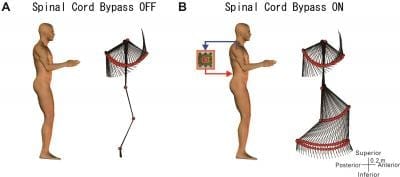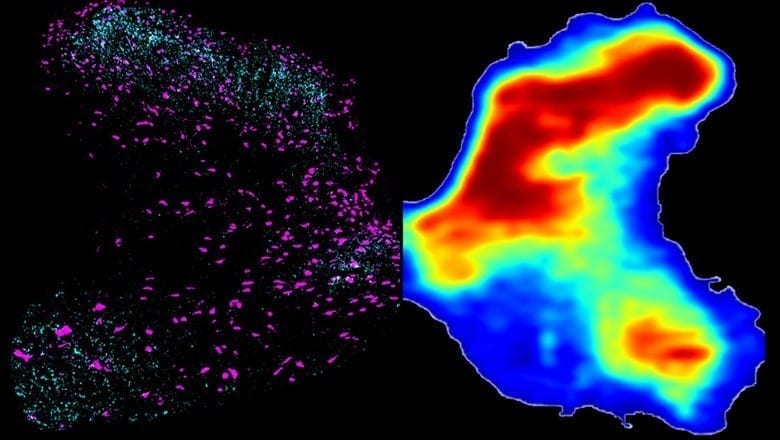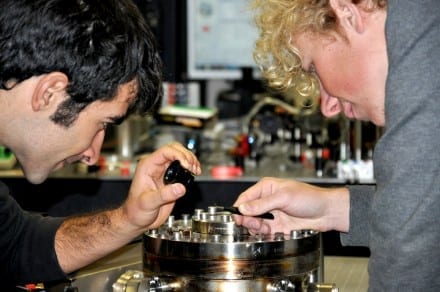
Credit: Yukio Nishimura
Potential rehabilitation of volitional walking in individuals with spinal cord injury
Gait disturbance in individuals with spinal cord injury is attributed to the interruption of neural pathways from brain to the spinal locomotor center, whereas neural circuits locate below and above the lesion maintain most of their functions. An artificial connection that bridges the lost pathway and connects brain to spinal circuits has potential to ameliorate the functional loss. A Japanese research group led by Shusaku Sasada, research fellow and Yukio Nishimura, associate professor of the National Institute for Physiological Sciences (NIPS), National Institutes of Natural Sciences (NINS) has successfully made an artificial connection from the brain to the locomotion center in the spinal cord by bypassing with a computer interface. This allowed subjects to stimulate the spinal locomotion center using volitionally-controlled muscle activity and to control walking in legs. This result was published online in The Journal of Neuroscience on August 13, 2014.
Neural networks in the spinal cord, locomotion center are capable of producing rhythmic movements, such as swimming and walking, even when isolated from the brain. The brain controls spinal locomotion center by sending command to the spinal locomotion center to start, stop and change waking speed. In most cases of spinal cord injury, the loss of this link from the brain to the locomotion center causes problems with walking.
The research group came up with bypassing the functioning brain and locomotion center with the computer to compensate lost pathways as a way to enable individuals with spinal cord injury to regain walking ability.
The Latest on: Spinal cord bypass
[google_news title=”” keyword=”Spinal cord bypass” num_posts=”10″ blurb_length=”0″ show_thumb=”left”]
via Google News
The Latest on: Spinal cord bypass
- Spinal Cord 'Wraparound' Device Could Help Treat Paralysison May 9, 2024 at 2:57 am
Johns Hopkins Medicine has more on spinal cord injury. A new wraparound device can help doctors study the spinal cord in greater detail than ever before, and eventually might be able to help restore ...
- Experimental device yields fresh hope for patients with spinal cord injurieson May 8, 2024 at 11:50 am
A combined science-medical team at Cambridge University in England has developed a new minimally invasive technique to treat spinal cord injuries with a miniature, wrap-around, electronic implant to r ...
- Engineers develop ‘wraparound’ device for spinal cord monitoring and treatmenton May 8, 2024 at 11:03 am
This approach inspired by microelectronics involves wrapping very thin, high-resolution implants around the whole spinal cord.
- Cambridge’s Flexible Implants Promise New Hope for Paralysis Patientson May 8, 2024 at 11:00 am
A tiny, flexible electronic device that wraps around the spinal cord could represent a new approach to the treatment of spinal injuries, which can cause profound disability and paralysis. A team of ...
- Tiny wraparound implants ‘represent new approach for spinal cord injuries’on May 8, 2024 at 11:00 am
A tiny, flexible electronic implant that wraps around the spinal cord could offer new ways to treat disability and paralysis-causing spinal injuries, a new study suggests.The devices have been ...
- Red light therapy for repairing spinal cord injury passes milestoneon May 6, 2024 at 6:43 am
Patients with spinal cord injury (SCI) could benefit from a future treatment to repair nerve connections using red and near-infrared light.
- Spinal Cord Compression: An Obstructive Oncologic Emergencyon May 3, 2024 at 5:01 pm
Spinal cord compression (SCC) occurs in 5% to 30% of the oncology population and affects patient function, comfort, and general quality of life. Patients with lung cancer, breast cancer ...
- Cerebrospinal Fluidon April 14, 2024 at 5:00 pm
Cerebrospinal fluid is the liquid around your brain and spinal cord. If a doctor thinks you have an illness that affects your nervous system, they might take a sample for testing. The fluid is ...
- Brainless memory makes the spinal cord smarter than previously thoughton April 10, 2024 at 5:00 pm
Researchers have discovered the neural circuitry in the spinal cord that allows brain-independent motor learning. The study found two critical groups of spinal cord neurons, one necessary for new ...
- What to know about severe spinal stenosison April 10, 2024 at 5:00 pm
which is the space in the center of the vertebrae containing the spinal cord and nerve roots. At its most severe or final stage — known as grade 3 — it can squeeze and change the spinal cord ...
via Bing News










